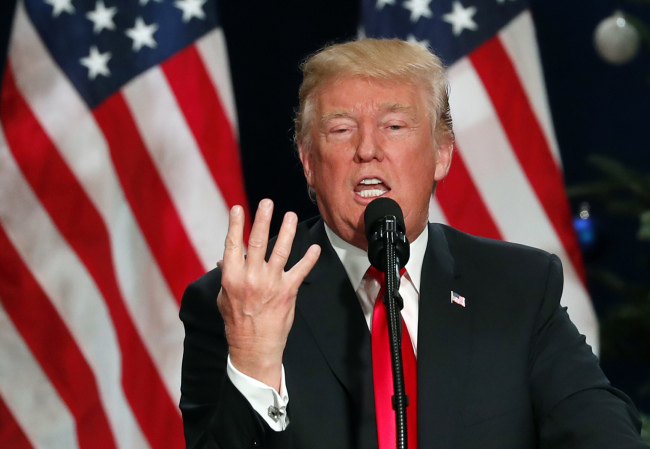WASHINGTON -- The Trump administration threatened new sanctions on North Korea on Wednesday after the reclusive government shattered two months of relative quiet with its most powerful weapon test yet, an intercontinental ballistic missile that some observers believe could reach Washington and the entire US Eastern Seaboard.

President Donald Trump tweeted that he spoke with Chinese President Xi Jinping about Pyongyang’s “provocative actions,” and he vowed that “additional major sanctions will be imposed on North Korea today. This situation will be handled!” Trump’s top diplomat, Rex Tillerson, said the US could target financial institutions doing business with the North.
US Ambassador Nikki Haley said Wednesday at an emergency meeting of the United Nations Security Council that the missile launch “brings us closer” to a war that the US doesn’t seek.
She said that if war comes as a result of further acts of “aggression” like the latest launch, “make no mistake the North Korean regime will be utterly destroyed.”
The fresh deliberations about new forms of punishment for North Korea came after its government said it successfully fired a “significantly more” powerful, nuclear-capable ICBM it called the Hwasong-15. Outside governments and analysts concurred the North had made a jump in missile capability.
A resumption of Pyongyang’s torrid testing pace in pursuit of a viable arsenal of nuclear-tipped missiles that can hit the US mainland had been widely expected. But the power of the missile and suddenness of the test jolted the Korean Peninsula and Washington. The launch at 3:17 a.m. Wednesday local time -- early Tuesday afternoon in the US capital -- indicated an effort to perfect the element of surprise and obtain maximum attention in the US.
In a government statement released through state media, North Korea said the Hwasong-15, the “greatest ICBM,” could be armed with a “super-large heavy nuclear warhead” and is capable of striking the “whole mainland” of the US. The North said the missile reached a height of 4,475 kilometers (2,780 miles) and traveled 950 kilometers before accurately hitting a sea target, similar to the flight data announced by South Korea’s military.
After the launch, it said leader Kim Jong-un “declared with pride” that his country has achieved its goal of becoming a “rocket power.” State TV said Kim gave the order Tuesday, and it broadcast a photo of Kim’s signed order where he wrote: “Test launch is approved. Taking place at the daybreak of Nov. 29! Fire with courage for the party and country!”
Speaking later Wednesday, Trump could not resist taking a dig at Kim. Digressing during a speech in Missouri on tax reform, Trump called Kim “Little Rocket Man” and described him as “a sick puppy.”
The North Korean launch was a message of defiance to the Trump administration, which a week earlier restored North Korea to a US list of terror sponsors. It also ruins nascent diplomatic efforts, raises fears of war or a pre-emptive US strike and casts a deeper shadow over the security of the Winter Olympics early next year in South Korea.
A rattled Seoul responded by almost immediately launching three of its own missiles in a show of force. South Korean President Moon Jae-in expressed worry that North Korea’s missile threat could force the US to attack the North before it masters a nuclear-tipped long-range missile.
“If North Korea completes a ballistic missile that could reach from one continent to another, the situation can spiral out of control,” Moon said at an emergency meeting in Seoul, according to his office. “We must stop a situation where North Korea miscalculates and threatens us with nuclear weapons or where the United States considers a pre-emptive strike.”
Moon has repeatedly declared the US cannot attack the North without Seoul’s approval. But Washington may act without South Korean input.
The launch was North Korea’s first since Sept. 15 and may have broken any efforts at diplomacy. US officials have sporadically floated the idea of direct talks with North Korea if it maintained restraint.
The missile also appeared an improvement on North Korea’s past launches.
If flown on a standard trajectory, instead of Wednesday’s lofted angle, the missile would have a range of more than 13,000 kilometers, said US scientist David Wright, a physicist who closely tracks North Korea’s missile and nuclear programs. “Such a missile would have more than enough range to reach Washington, D.C., and in fact any part of the continental United States,” Wright wrote in a blog post for the Union for Concerned Scientists.
Japanese Defense Minister Itsunori Onodera said the missile landed inside Japan’s special economic zone in the Sea of Japan.
A big unknown, however, is the missile’s payload. If, as expected, it carried a light mock warhead, then its effective range would have been shorter, analysts said.
In his call with Xi, Trump made clear “the determination of the United States to defend ourselves and our allies,” according to a White House statement. Trump also “emphasized the need for China to use all available levers to convince North Korea to end its provocations and return to the path of denuclearization.”
The Trump administration bolstered US sanctions against North Korea last week and imposed new restrictions on North Korean shipping firms and Chinese companies that deal with the North.
China’s state-run Xinhua news agency said Xi told Trump that China remained determined to clear the Korean Peninsula of nuclear weapons, and to preserve peace and stability in Northeast Asia. (AP)




![[Herald Interview] 'Amid aging population, Korea to invite more young professionals from overseas'](http://res.heraldm.com/phpwas/restmb_idxmake.php?idx=644&simg=/content/image/2024/04/24/20240424050844_0.jpg&u=20240424200058)













![[KH Explains] Korean shipbuilding stocks rally: Real growth or bubble?](http://res.heraldm.com/phpwas/restmb_idxmake.php?idx=652&simg=/content/image/2024/04/25/20240425050656_0.jpg&u=)

